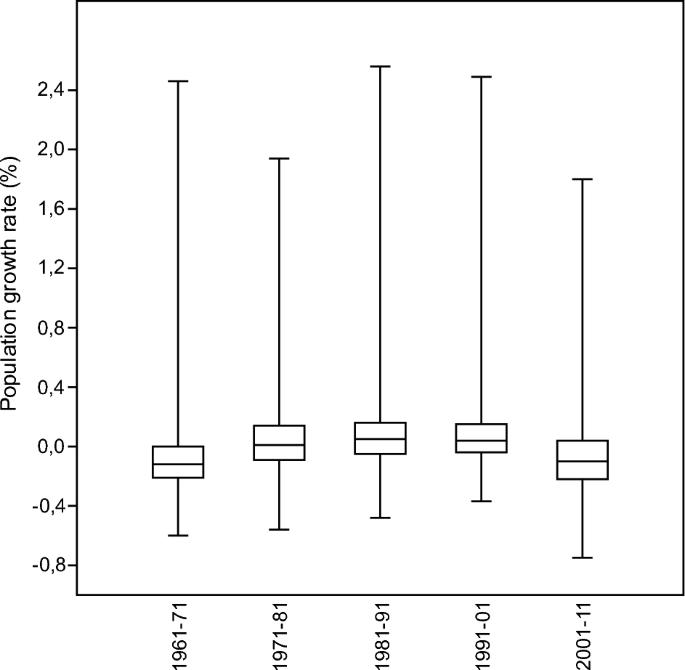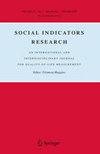用空间分位数和地理加权回归测试希腊密度依赖和路径依赖的人口动态
IF 2.8
2区 社会学
Q1 SOCIAL SCIENCES, INTERDISCIPLINARY
引用次数: 0
摘要
常住人口空间分布的区域差异和跨国密度差异巩固了欧洲现代城市系统基础上的异质人口模式。虽然经济、历史、制度和文化因素已被证明会影响常住人口的空间分布,但密度依赖和路径依赖是在地方和区域尺度上持续塑造人口动态的机制。在足够长的时间间隔内对人口增长(和下降)的密度依赖模式进行分析,可以更好地理解人口差异背后的社会经济过程。尽管有悠久的定居历史,但对人口密度依赖在城乡梯度长期演变中的作用的实证调查相对较少,特别是在地中海国家。本研究采用空间隐式和显式计量经济学方法,对1961年至2011年间希腊1033个城市的人口分布进行了比较分析,以确定(并检验)密度依赖和路径依赖的人口增长机制。研究结果突出表明,在聚落集中的地区,密度对人口增长有积极影响。假设检验模型的拟合优度代表了密度依赖,实证结果阐明了密度依赖机制在整个研究期间并不显著,而是与城市生命周期的特定阶段有关——基本上是人口集中在中心位置的城市化。当人口以中低密度分布在更大的区域时,郊区化和反城市化对密度的依赖程度较低。对人口增长的密度依赖和路径依赖机制的更好理解有助于重新思考适应异质(和快速变化)的地方环境的空间规划、区域发展战略和社会人口政策。本文章由计算机程序翻译,如有差异,请以英文原文为准。

Testing Density-Dependent and Path-Dependent Population Dynamics in Greece with Spatial Quantile and Geographically Weighted Regressions
Abstract Regional variability in the spatial distribution of resident population and across-country density divides have consolidated heterogeneous demographic patterns at the base of modern urban systems in Europe. Although economic, historical, institutional, and cultural factors have demonstrated to affect the spatial distribution of resident population, density-dependence and path-dependence are mechanisms persistently shaping demographic dynamics at both local and regional scale. Analysis of density-dependent patterns of population growth (and decline) over sufficiently long time intervals allows a refined comprehension of socioeconomic processes underlying demographic divides. Despite a long settlement history, empirical investigation of the role of density-dependence in the long-term evolution of human populations along urban–rural gradients is relatively scarce especially in Mediterranean countries. The present study performs a comparative analysis of population distribution in 1033 Greek municipalities identifying (and testing the significance of) density-dependent and path-dependent mechanisms of population growth between 1961 and 2011, using spatially implicit and explicit econometric approaches. Results highlight a positive impact of density on population growth where settlements are concentrated. Assuming goodness of fit of the tested models as a proxy of density-dependence, the empirical findings clarify how density-dependent mechanisms were not significant all over the study period, being instead associated with specific phases of the city life cycle—basically urbanization with population concentrating in central locations. Density-dependence was less intense with suburbanization and counter-urbanization—when population sprawled over larger areas at medium–low density. An improved understanding of density-dependent and path-dependent mechanisms of population growth contributes to rethink spatial planning, regional development strategies, and socio-demographic policies adapting to heterogeneous (and rapidly changing) local contexts.
求助全文
通过发布文献求助,成功后即可免费获取论文全文。
去求助
来源期刊

Social Indicators Research
Multiple-
CiteScore
6.30
自引率
6.50%
发文量
174
期刊介绍:
Since its foundation in 1974, Social Indicators Research has become the leading journal on problems related to the measurement of all aspects of the quality of life. The journal continues to publish results of research on all aspects of the quality of life and includes studies that reflect developments in the field. It devotes special attention to studies on such topics as sustainability of quality of life, sustainable development, and the relationship between quality of life and sustainability. The topics represented in the journal cover and involve a variety of segmentations, such as social groups, spatial and temporal coordinates, population composition, and life domains. The journal presents empirical, philosophical and methodological studies that cover the entire spectrum of society and are devoted to giving evidences through indicators. It considers indicators in their different typologies, and gives special attention to indicators that are able to meet the need of understanding social realities and phenomena that are increasingly more complex, interrelated, interacted and dynamical. In addition, it presents studies aimed at defining new approaches in constructing indicators.
 求助内容:
求助内容: 应助结果提醒方式:
应助结果提醒方式:


